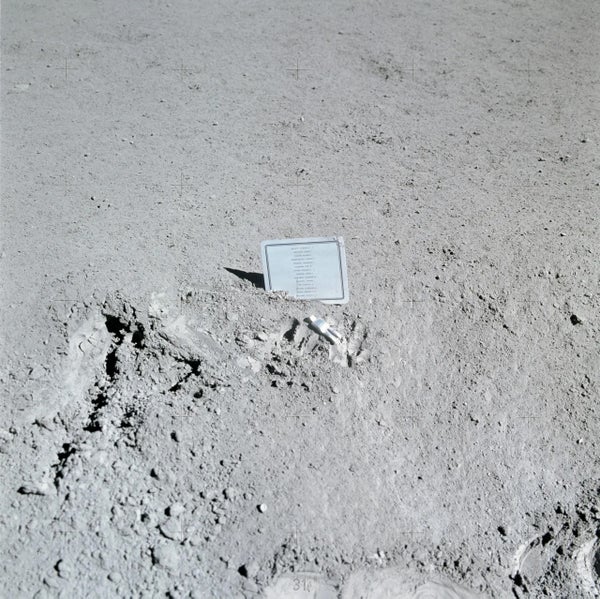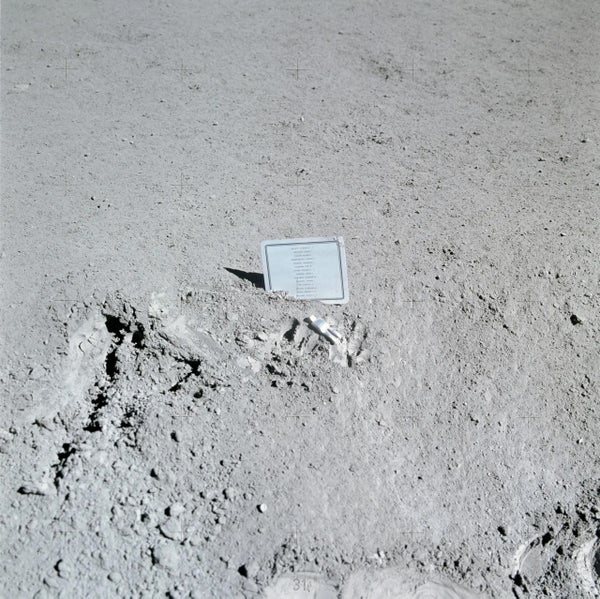Sculptures about to Land on the Moon Join a Long History of Lunar Art
A lunar lander nicknamed Odie carries 125 small moon sculptures by artist Jeff Koons that could become the first authorized artwork on the moon

Close-up of a memorial plaque on the Moon at Hadley-Apennine site, honoring 14 deceased NASA astronauts and USSR cosmonauts. Astronauts David R. Scott and James B. Irwin installed it during Apollo 15’s lunar surface activity. The figurine symbolizes fallen space explorers.
If all goes smoothly, the moon’s robotic population will increase by one on February 22 with the scheduled touchdown of the NASA-funded lander Odysseus, nicknamed Odie. Among its cargo are 125 miniature sculptures of the moon that their creator, artist Jeff Koons, has billed as “the first authorized artwork on the moon.”
Launched on February 15, Odie was built by the Houston-based company Intuitive Machines. It carries six NASA instruments, as well as a host of commercial payloads, including the Koons moons. Each one-inch moon headed to the lunar surface has two counterparts that will stay on Earth: a larger statue and a digital version in the form of a nonfungible token, or NFT.
“Authorized” is an important word when billing the sculpture as a “first” on the moon. Even if the Intuitive Machines landing goes smoothly, Koons’s sculptures probably won’t be the first art to touch down on our closest companion in space—although the matter is surprisingly slippery.
On supporting science journalism
If you’re enjoying this article, consider supporting our award-winning journalism by subscribing. By purchasing a subscription you are helping to ensure the future of impactful stories about the discoveries and ideas shaping our world today.
The lead contender for the first art on the moon would have touched down in 1969 on the lunar module of the Apollo 12 mission. Dubbed the “Moon Museum,” the piece was a stamp-sized tile sporting drawings by six leading artists of the time, including Andy Warhol and Robert Rauschenberg. Although the coalition asked NASA to approve the endeavor, it didn’t receive a response.
“At the time, the concept of putting art on the moon was an avant-garde idea for the NASA administrator,” says Carolyn Russo, art curator at the National Air and Space Museum in Washington, D.C. “They tried to get official permission, and they were not able to.”
And so they went rogue. Allegedly, a NASA engineer snuck the tile onto the lunar module’s leg, beneath the brilliant gold layers of insulation, before the mission blasted off. There’s no photograph of the Moon Museum in place, however; the only way to be sure the tile made it would be to visit the lander’s outpost on the moon. (There are also copies that remain on Earth, including one held by the Museum of Modern Art in New York City.)
“Now I know that there’s a soulful piece of art up there—a piece of software among all that hardware and junk,” artist Forrest Myers, who led the endeavor, told the New York Times in an article published on November 22, 1969, when the project was made public.
Russo argues that the Moon Museum, assuming it reached its destination, is the only true art on the moon. She says that in her opinion, to qualify, projects must fly intentionally as art for the purpose of art. In her view, that would disqualify another Apollo-era item, a small aluminum statue that came to be called “Fallen Astronaut.”
That statue was designed by artist Paul van Hoeydonck and placed on the moon’s surface by Apollo 15 astronaut David Scott in 1971, accompanied by a plaque listing 14 American astronauts and Soviet cosmonauts who died in the quest to reach space. Scott said that he considered the statue a tribute to colleagues, although van Hoeydonck has since said that he approached the piece as art.
And just as the roots of art on the moon stretch back to the early days of lunar exploration, Koons isn’t alone in turning his artistic vision to our nearest neighbor.
The Intuitive Machines mission comes on the heels of another U.S. commercial moon landing attempt, a spacecraft called Peregrine that failed to reach the moon in January. That lander carried an art plaque by British artist Sacha Jafri as well as a small sculpture dubbed MoonArk, created by a large collaboration led by Carnegie Mellon University, that contained images, poems, music and other materials.
“Humankind has always expressed itself through art, and the moon has served as an inspiration from the beginning of time,” Russo says. “Why wouldn’t artists look to the moon as a new place to offer a new cultural understanding of who we are as a civilization?”

